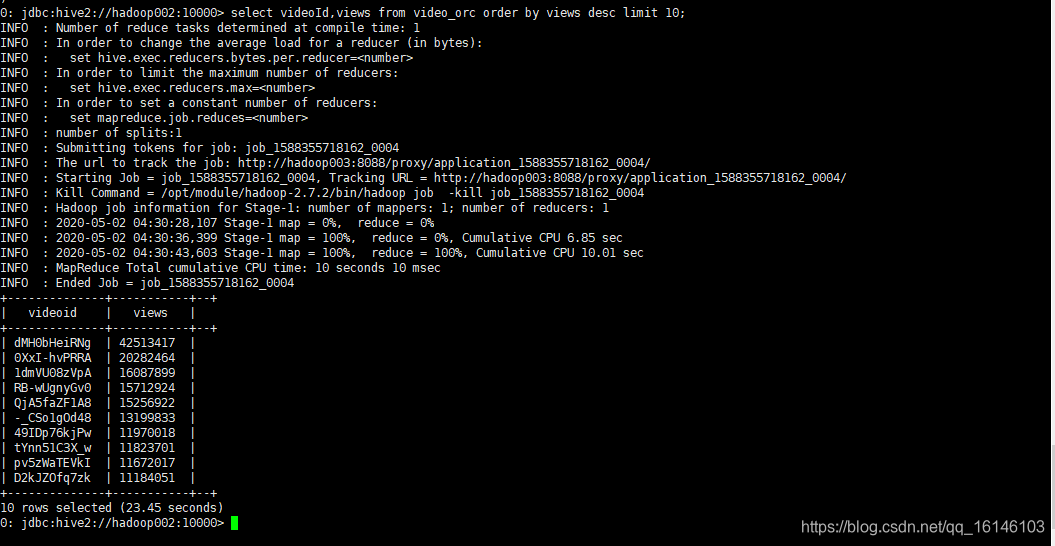Hive项目实战系列(3) | 业务分析
此次博主为大家带来的是Hive项目实战系列的第三部分,也是最终部分。
- 我们先来测试一下
0: jdbc:hive2://hadoop002:10000> select * from video_orc order by views desc limit 10;
- 1

这时候出现了内存溢出的现象。
- 再次测试
0: jdbc:hive2://hadoop002:10000> select videoId,views from video_orc order by views desc limit 10;
- 1

由此可以得到以下结论,不要带* 否则会出现堆溢出
1. 统计视频观看数Top10
思路:使用order by按照views字段做一个全局排序即可,同时我们设置只显示前10条。
最终代码:
select videoId, uploader, age, category, length, views, rate, ratings, comments
from video_orc
order by views
desc limit 10;
- 1
- 2
- 3
- 4
- 5
- 6
- 7
- 8
- 9
- 10
- 11
- 12
- 13
- 14
- 15
- 16
- 17

2. 统计视频类别热度Top10
思路:
1.即统计每个类别有多少个视频,显示出包含视频最多的前10个类别。
2. 我们需要按照类别group by聚合,然后count组内的videoId个数即可。
3.因为当前表结构为:一个视频对应一个或多个类别。所以如果要group by类别,需要先将类别进行列转行(展开),然后再进行count即可。
4.最后按照热度排序,显示前10条。
最终代码:
select category_name as category, count(t1.videoId) as hot
from ( select videoId, category_name from video_orc lateral view explode(category) t_catetory as category_name) t1
group by t1.category_name
order by hot
desc limit 10;
- 1
- 2
- 3
- 4
- 5
- 6
- 7
- 8
- 9
- 10
- 11
- 12
- 13
- 14
- 15
- 16

3. 统计出视频观看数最高的20个视频的所属类别以及类别包含Top20视频的个数
思路:
1.先找到观看数最高的20个视频所属条目的所有信息,降序排列
2.把这20条信息中的category分裂出来(列转行)
3.最后查询视频分类名称和该分类下有多少个Top20的视频
最终代码:
select category_name as category, count(t2.videoId) as hot_with_views
from ( select videoId, category_name from ( select * from video_orc order by views desc limit 20) t1 lateral view explode(category) t_catetory as category_name) t2
group by category_name
order by hot_with_views
desc;
- 1
- 2
- 3
- 4
- 5
- 6
- 7
- 8
- 9
- 10
- 11
- 12
- 13
- 14
- 15
- 16
- 17
- 18
- 19
- 20
- 21
- 22

4. 统计视频观看数Top50所关联视频的所属类别排序
思路:
1.查询出观看数最多的前50个视频的所有信息(当然包含了每个视频对应的关联视频),记为临时表t1
2.将找到的50条视频信息的相关视频relatedId列转行,记为临时表t2
3. 将相关视频的id和gulivideo_orc表进行inner join操作
4. 按照视频类别进行分组,统计每组视频个数,然后排行
- 1. 观看数前50的视频
select *
from video_orc
order by views
desc limit 50;
- 1
- 2
- 3
- 4
- 5
- 6
- 7
- 8
- 9
- 2. 将相关视频的id进行列转行操作
select explode(relatedId) as videoId
from
t1;
- 1
- 2
- 3
- 4
- 5
- 3. 得到两列数据,一列是category,一列是之前查询出来的相关视频id
(select distinct(t2.videoId), t3.category
from t2
inner join video_orc t3 on t2.videoId = t3.videoId) t4 lateral view explode(category) t_catetory as category_name;
- 1
- 2
- 3
- 4
- 5
- 6
- 7
- 8
- 4. 按照视频类别进行分组,统计每组视频个数,然后排行
最终代码
select category_name as category, count(t5.videoId) as hot
from ( select videoId, category_name from ( select distinct(t2.videoId), t3.category from ( select explode(relatedId) as videoId from ( select * from video_orc order by views desc limit 50) t1) t2 inner join video_orc t3 on t2.videoId = t3.videoId) t4 lateral view explode(category) t_catetory as category_name) t5
group by category_name
order by hot
desc;
- 1
- 2
- 3
- 4
- 5
- 6
- 7
- 8
- 9
- 10
- 11
- 12
- 13
- 14
- 15
- 16
- 17
- 18
- 19
- 20
- 21
- 22
- 23
- 24
- 25
- 26
- 27
- 28
- 29
- 30
- 31

5. 统计每个类别中的视频热度Top10,以Music为例
思路:
1.要想统计Music类别中的视频热度Top10,需要先找到Music类别,那么就需要将category展开,所以可以创建一张表用于存放categoryId展开的数据。
2. 向category展开的表中插入数据。
3. 统计对应类别(Music)中的视频热度。
最终代码:
- 1. 创建表类别表:
create table gulivideo_category( videoId string, uploader string, age int, categoryId string, length int, views int, rate float, ratings int, comments int, relatedId array<string>)
row format delimited
fields terminated by "\t"
collection items terminated by "&"
stored as orc;
- 1
- 2
- 3
- 4
- 5
- 6
- 7
- 8
- 9
- 10
- 11
- 12
- 13
- 14
- 15
- 16
- 2. 向类别表中插入数据:
insert into table gulivideo_category select videoId, uploader, age, categoryId, length, views, rate, ratings, comments, relatedId from video_orc lateral view explode(category) catetory as categoryId;
- 1
- 2
- 3
- 4
- 5
- 6
- 7
- 8
- 9
- 10
- 11
- 12
- 13
- 14
- 15
- 3. 统计Music类别的Top10(也可以统计其他)
select videoId, categories, views
from gulivideo_category
where categoryId = "Music"
order by views
desc limit 10;
- 1
- 2
- 3
- 4
- 5
- 6
- 7
- 8
- 9
- 10
- 11
- 12
- 13

6. 统计每个类别中视频流量Top10,以Music为例
思路:
1.创建视频类别展开表(categoryId列转行后的表)
2.按照ratings排序即可
最终代码:
select videoId, views, ratings
from gulivideo_category
where categoryId = "Music"
order by ratings
desc limit 10;
- 1
- 2
- 3
- 4
- 5
- 6
- 7
- 8
- 9
- 10
- 11
- 12
- 13

7. 统计每个类别视频观看数Top10
思路:
1.先得到categoryId展开的表数据
2.子查询按照categoryId进行分区,然后分区内排序,并生成递增数字,该递增数字这一列起名为rank列
3.通过子查询产生的临时表,查询rank值小于等于10的数据行即可。
最终代码:
select t1.*
from ( select videoId, categoryId, views, row_number() over(partition by categoryId order by views desc) rank from gulivideo_category) t1
where rank <= 10;
- 1
- 2
- 3
- 4
- 5
- 6
- 7
- 8
- 9
- 10
- 11

好了,关于此次实战的全部内容已经更新完毕了。

看 完 就 赞 , 养 成 习 惯 ! ! ! \color{#FF0000}{看完就赞,养成习惯!!!} 看完就赞,养成习惯!!!^ _ ^ ❤️ ❤️ ❤️
码字不易,大家的支持就是我坚持下去的动力。点赞后不要忘了关注我哦!
文章来源: buwenbuhuo.blog.csdn.net,作者:不温卜火,版权归原作者所有,如需转载,请联系作者。
原文链接:buwenbuhuo.blog.csdn.net/article/details/105881999
- 点赞
- 收藏
- 关注作者


评论(0)